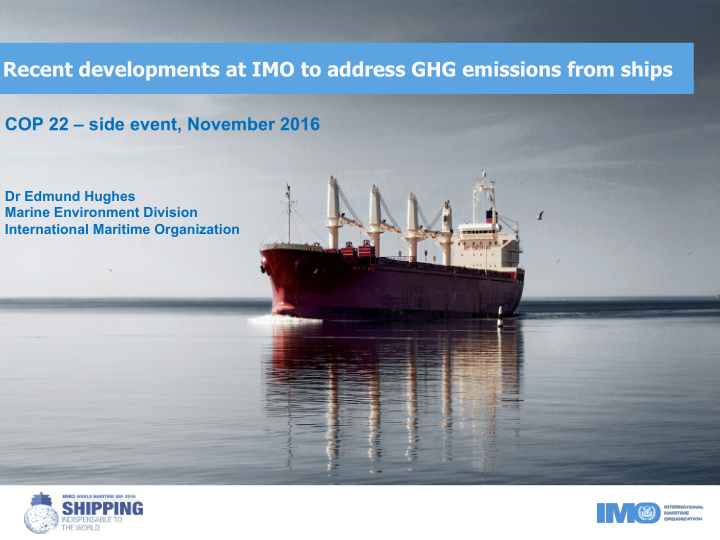



Recent developments at IMO to address GHG emissions from ships COP 22 – side event, November 2016 Dr Edmund Hughes Marine Environment Division International Maritime Organization
CO2 emissions from shipping forecast to grow Ref: Third IMO GHG Study 2014 § Shipping CO2 emissions are projected to increase by 50% to 250% in the period to 2050, despite fleet average efficiency improvements of about 40% and in the absence of further regulations § Demand is the primary driver § Technical and operational efficiency measures can provide significant improvements but will not be able to provide total net reductions if demand continues § Changes in the fuel mix have a limited impact on GHG emissions
Three-step approach to consider further measures to enhance the energy efficiency of ships MEPC 68 (May 2015) agreed a three-step approach: 1. Data collection 2. Data analysis 3. Decision-making on what further measures, if any, are required Step 1: data collection will provide the basis for an objective, transparent and inclusive policy debate in the MEPC 3
Data collection system for fuel oil consumption § Ships of 5,000 gross tonnage and above (85% of CO2 emissions) will be required to submit to their Administration annual reports on fuel oil consumption and transport work parameters, via a methodology included in the Ship Energy Efficiency Management Plan (SEEMP) § Administrations to submit aggregated data to IMO, which will maintain an anonymised IMO Ship Fuel Oil Consumption Database § Regulation 22A is expected to enter into force on 1 March 2018, with first data “calendar year” beginning 1 January 2019 4
New appendix IX - Information to be submitted to IMO Ship Fuel Oil Consumption Database IMO number § Period of calendar year covered § Technical characteristics of the ship § - Ship type - Gross tonnage (GT) - Net tonnage (NT) - Deadweight tonnage (DWT) - Power output (rated power) of main and auxiliary engines (kW) EEDI (if applicable) § Ice class § Fuel oil consumption, by fuel oil type, in metric tonnes and methods § used for collecting fuel oil consumption data Distance travelled (over ground), hours underway §
Reduction of GHG emissions from ships
Reduction of GHG emissions from ships • MEPC welcomed the Paris Agreement on Climate Change and recognized it as a major achievement by the international community. It also unanimously recognized IMO's own role in mitigating the impact of GHG emissions from international shipping and recognized and agreed that further appropriate improvements related to shipping emissions can and should be pursued. • MEPC approved Roadmap for development of a ‘Comprehensive IMO strategy on reduction of GHG emissions from ships’ to enable MEPC address several important questions including what role should international shipping sector have in supporting the Paris Agreement to provide a long- term vision for the shipping sector • Initial strategy to be adopted in 2018 • List of activities, including further IMO GHG studies, with relevant timelines • Alignment of activities with the three-step approach for further measures • Provides a way forward for adoption of a revised strategy in 2023 to include short-, mid-, and long-term further measures, as required, with implementation schedules 7
Roadmap for development of a ‘Comprehensive IMO strategy on reduction of GHG emissions from ships’ Discussions should include but not be limited to the elements below: • Levels of ambition and guiding principles for the strategy; • Emissions scenarios; • Assessment of the projected future demand for shipping; • Parameters/indicators on energy efficiency of ships (current status and long-term potential); • Emission reduction opportunities (near-, mid- and long-term actions), including alternative fuels; • Costs and benefits; • Capacity building and technical cooperation; • Barriers to emissions reductions and how to overcome them; • Priority areas for R&D, including in relation to technology; • Impact of EEDI; • Impacts on States, taking into account the HLAP (resolution A.1098(29)); and • Impacts of other regulations on GHG emissions 8
Thank you for your attention 9
Recommend
More recommend